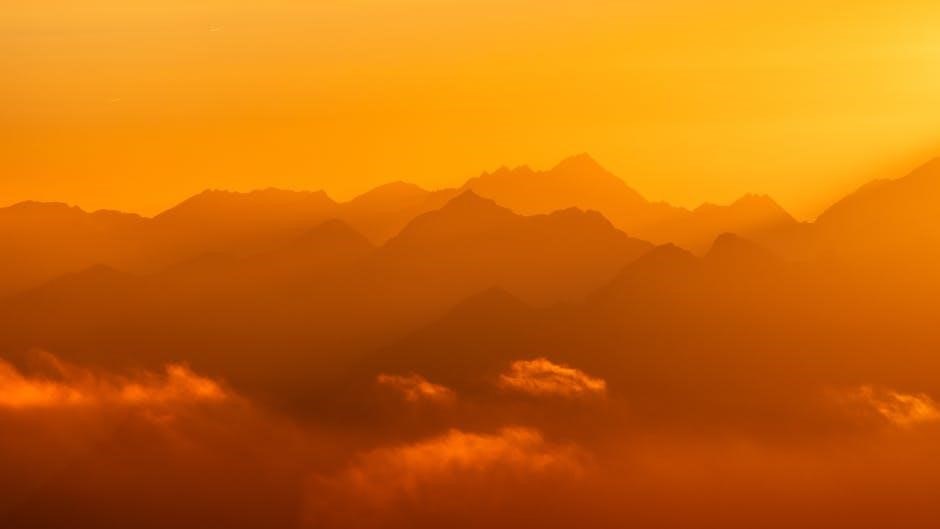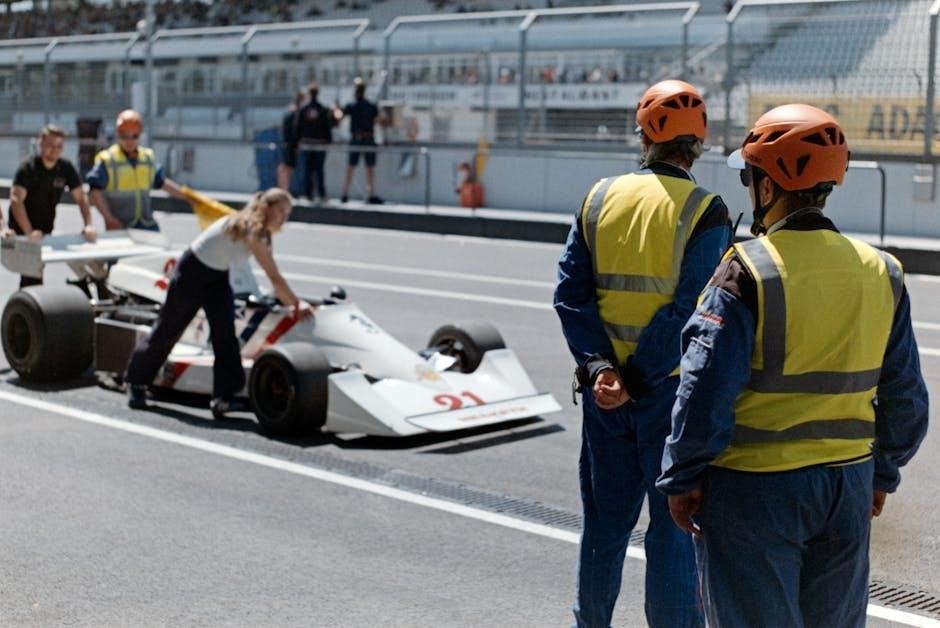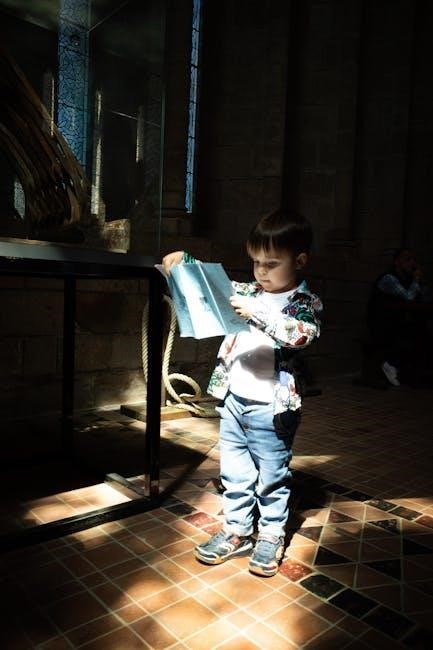The Tour du Mont Blanc is a 170 km trek circling Europe’s highest mountain, offering breathtaking Alpine views across France, Italy, and Switzerland. A self-guided journey provides flexibility, allowing hikers to explore at their own pace, immersing in stunning landscapes and experiencing a once-in-a-lifetime adventure.
Overview of the Mont Blanc Circuit
The Mont Blanc Circuit is a 170 km trail looping around Europe’s highest mountain, spanning France, Italy, and Switzerland. This iconic route features challenging terrain with over 10,000 meters of elevation gain, offering breathtaking views of glaciers, valleys, and traditional villages. Popular among experienced hikers, the circuit combines stunning Alpine landscapes with rich cultural experiences, making it a must-do adventure for those seeking a memorable trekking experience in the heart of the Alps.
Why Choose a Self-Guided Tour?
A self-guided tour of the Mont Blanc Circuit offers unparalleled flexibility, allowing hikers to explore at their own pace and enjoy the scenery without rigid schedules. This option is ideal for independent travelers who value autonomy and prefer to immerse themselves in the Alpine beauty without the constraints of a group. With detailed itineraries and support services like baggage transfers, hikers can focus on the adventure, creating a personalized experience tailored to their preferences and abilities.
Planning and Preparation for the Mont Blanc Circuit
Thorough planning is essential for a successful self-guided Mont Blanc Circuit. Customize your itinerary, assess physical fitness, and book accommodations early to ensure a smooth, enjoyable trek.
Customizable Itineraries: 7-Day, 8-Day, 10-Day, and 15-Day Options
Choose from 7-day, 8-day, 10-day, or 15-day itineraries to suit your hiking style and schedule. The classic 10-day circuit provides ample time to complete the full trek, while shorter options like the 7-day or 8-day itineraries cater to those with limited time. For a more relaxed pace, the 15-day option offers extra days to explore side trails and enjoy the stunning Alpine scenery. These customizable plans ensure a personalized and unforgettable Mont Blanc Circuit experience.
Best Time to Embark on the Journey
The ideal time to tackle the Mont Blanc Circuit is between mid-June and mid-September, when the weather is warm and trails are clear of snow. July and August offer the best conditions, with wildflowers in bloom and long daylight hours. However, these months are also the busiest. For a quieter experience, consider June or September, when the crowds are smaller and the scenery remains spectacular. Always check local forecasts before starting your trek.
Physical Condition and Experience Required
The Mont Blanc Circuit demands a good level of physical fitness and hiking experience. Hikers should be comfortable with daily treks of 15-20 km, involving significant elevation gains and descents. While prior trekking experience is beneficial, determination and endurance are equally important. The trail is challenging but manageable for those who prepare adequately. Proper training and acclimatization are key to enjoying this iconic journey through the Alps. Strength and stamina are essential for carrying a backpack and navigating varied terrain.
Navigation and Route-Finding Tips
Thorough preparation is essential for navigating the Mont Blanc Circuit. Carry detailed maps, a compass, and a GPS device or app like Komoot. Download GPX files for accurate route tracking. Mark key waypoints and turns in advance. Pay attention to trail signs and yellow-and-white markers. Stay visible by wearing bright clothing and consider hiring a guide for complex sections. Always check the weather and trail conditions before starting each day. Local advice from rifugios or hikers can also provide valuable insights.

Accommodation Options for the Mont Blanc Circuit
The Mont Blanc Circuit offers diverse lodging, from cozy mountain rifugios to boutique hotels. Choose between classic or comfort options, ensuring bookings are made well in advance.
Classic vs. Comfort Accommodation Choices
Classic options offer rustic charm, with shared facilities and hearty meals, ideal for budget-conscious hikers. Comfort choices provide ensuite rooms, gourmet dining, and modern amenities, perfect for those seeking relaxation after a day’s trek. Both options ensure a memorable stay, but early booking is essential to secure preferred accommodations along the Mont Blanc Circuit, especially during peak season.
Mountain Rifugios and Boutique Hotels
Mountain rifugios offer a rustic, communal experience with shared facilities and hearty local meals, perfect for hikers seeking authenticity. Boutique hotels provide luxury, with private rooms, gourmet dining, and modern amenities, ideal for those wanting comfort. Both options immerse you in Alpine charm, but rifugios emphasize simplicity and camaraderie, while boutique hotels focus on relaxation and indulgence. Early booking is crucial, especially during peak season, to secure your preferred accommodation along the Mont Blanc Circuit.
Baggage Transfers and Logistics
Baggage transfers simplify your self-guided Mont Blanc Circuit journey, allowing you to hike with just a daypack. Many tour packages include daily luggage transport between accommodations, ensuring your gear arrives before you. This service enhances convenience and reduces fatigue, letting you focus on the trail. Logistical support often includes 24-hour customer assistance, providing peace of mind. Early booking is recommended to secure seamless transfers, as availability can be limited during peak seasons. This arrangement ensures a smooth and enjoyable trekking experience.
Highlights and Must-See Spots on the Mont Blanc Circuit
The Mont Blanc Circuit offers breathtaking mountain vistas, stunning glaciers, and picturesque valleys. Explore iconic spots like Chamonix and Courmayeur, and marvel at waterfalls.
Breathtaking Views of Mont Blanc from Different Angles
The Mont Blanc Circuit offers ever-changing perspectives of Europe’s highest peak. From Chamonix’s dramatic valleys to Courmayeur’s serene landscapes, hikers are treated to grandstand views. The Aiguille du Midi cable car provides a thrilling vantage point, while the French, Italian, and Swiss sides reveal unique facets of the mountain. Witness Mont Blanc’s majesty reflected in alpine lakes, its glaciers glistening under sunlight, and its rugged beauty framed by picturesque villages and towering peaks.
Exploring Chamonix, Courmayeur, and Other Key Locations
Chamonix, the iconic starting point, captivates with its vibrant atmosphere and stunning mountain backdrop. Courmayeur, nestled in Italy, offers charming cobblestone streets and exquisite cuisine. Les Contamines and Argentière provide serene escapes with traditional Alpine charm. These key locations blend cultural richness with breathtaking vistas, allowing hikers to immerse in local traditions and history while enjoying the natural beauty of the Mont Blanc region.
Scenic Valleys, Glaciers, and Waterfalls
The Mont Blanc Circuit is renowned for its pristine valleys, majestic glaciers, and cascading waterfalls. The Bionnassay Valley stands out with its lush greenery and serene trails, while the stunning glaciers of Mont Blanc glisten under the sun. Waterfalls like those near Les Contamines add to the trail’s beauty, offering moments of tranquility and awe. These natural wonders create a breathtaking backdrop for hikers, making the journey a visual feast.
Packing Essentials for the Mont Blanc Circuit
Lightweight, durable hiking gear, weather-appropriate clothing, sturdy footwear, and navigation tools are must-haves for a successful self-guided journey on the Mont Blanc Circuit.
Lightweight and Durable Hiking Gear
For the Mont Blanc Circuit, prioritize lightweight yet durable hiking gear to ensure ease of movement and resilience against rough terrain. Opt for high-quality trekking poles, a sturdy backpack with rain protection, and moisture-wicking, breathable fabrics. Choose gear designed for multi-day treks, balancing weight and durability to handle the circuit’s demanding trails. Select items based on your itinerary length and physical condition to maintain comfort throughout the journey. Proper gear ensures a safer, more enjoyable trekking experience.
Weather-Appropriate Clothing and Footwear
Dress in layers for the Mont Blanc Circuit, using breathable, moisture-wicking fabrics to manage varying temperatures. Include a waterproof jacket and pants for rain, and sturdy, waterproof hiking boots with excellent grip for uneven paths. Consider insulating layers for cooler mornings and descents. Footwear should be durable with good ankle support due to the terrain’s demands. Weather can change rapidly, so pack versatile clothing to adapt to conditions, ensuring comfort and safety throughout your trek.
Navigation Tools and Safety Equipment
Essential navigation tools include detailed maps, a compass, and a GPS device or smartphone app. Carry a whistle and emergency shelter for unforeseen situations. A first-aid kit is crucial for minor injuries, while trekking poles can aid stability on uneven terrain. Ensure all electronics are water-resistant and carry extra batteries. Consider a personal locator beacon (PLB) for remote areas. Always inform someone of your itinerary and check weather forecasts to stay prepared and safe throughout your journey.
Budgeting and Cost Considerations
Plan for €80-€120 per day, covering accommodation, meals, and transfers. Budget extra for transportation and optional activities. Early booking ensures availability and optimal pricing for your trek.
Estimating Costs for Accommodation and Food
Accommodation costs vary between €50-€150 per night, depending on whether you choose classic mountain rifugios or boutique hotels. Meals range from €15-€30 for basic meals in refuges to €50-€100 in mid-range restaurants. Budgeting around €80-€120 per day for accommodation and food is recommended. Early booking can secure better rates, especially during peak season. Additionally, consider pre-booking meals in popular areas to avoid higher costs. Plan accordingly to enjoy your trek without financial stress.
Transportation and Baggage Transfer Fees
Transportation costs include local buses and cable cars, typically €2-€15 per ride. Baggage transfers, which transport luggage between accommodations, cost €20-€40 per day. Many self-guided tours include baggage transfers, while others offer it as an optional service. Public transportation fees can add up, so budgeting €30-€50 daily for these expenses is advisable. Pre-booking transfers and transportation passes can help reduce overall costs and streamline your journey.
Optional Activities and Their Costs
Optional activities like cable car rides (e.g., Aiguille du Midi, €30-€60) or guided ascents (€60-€100/day) enhance your experience. Wine tastings (€20-€40) and cultural tours offer local immersion. These extras are not included in base packages but can be booked separately, allowing flexibility based on your interests and budget. Pre-booking is recommended to secure spots and avoid higher on-site prices.

Safety and Emergency Preparedness
Carry a first-aid kit, emergency shelter, and a GPS device. Stay informed about weather conditions and know emergency protocols. Always inform someone of your route and expected return time. Be prepared for changing mountain conditions and know when to seek help if needed. Ensure you have necessary safety equipment and contingency plans for unpredictable situations during your trek. Stay vigilant and prioritize caution to ensure a safe journey. Remember, safety is your top priority in the mountains.
Emergency Contact Information and Protocols
Carry a list of emergency contacts, including local authorities and mountain rescue services. In the EU, dial 112 for emergencies. For specific regions:
- France: 15 for medical emergencies, 17 for police.
- Italy: 118 for medical emergencies, 113 for police.
- Switzerland: 144 for medical emergencies, 117 for police.
Keep a phone with a European SIM card and ensure it has emergency numbers saved. Inform your accommodations or a trusted contact about your itinerary. Carry a GPS device or emergency beacon for areas with no signal. Always know the nearest rescue post or mountain hut. Stay prepared and informed to handle any situation quickly and effectively. Safety is paramount in the mountains.
First Aid and Medical Considerations
A well-stocked first aid kit is essential for the Mont Blanc Circuit. Include bandages, antiseptic wipes, painkillers, and blister care. Altitude sickness can occur, so monitor symptoms like headaches or fatigue. Carry personal medications and know how to use items like an EpiPen or splint. Stay hydrated and take regular breaks to prevent exhaustion. In case of severe injury or illness, seek medical help promptly. Familiarize yourself with basic first aid techniques for sprains, cuts, and altitude-related issues. Always carry a phone for emergencies. Be prepared to respond quickly to medical situations.
Weather Conditions and Hazard Management
The Mont Blanc Circuit experiences unpredictable Alpine weather, with sudden rain, snow, or strong winds possible. Stay informed with local forecasts and be prepared for changing conditions. Hazards include steep drop-offs, loose rocks, and fast-flowing streams. Use trekking poles for stability and ensure proper footwear for uneven terrain. Carry a map, GPS, or app for navigation. Assess your ability to handle challenging sections and seek alternative routes if necessary. Always prioritize safety and carry emergency gear.

Environmental Considerations and Responsible Hiking
Practicing Leave No Trace is essential on the Mont Blanc Circuit. Protect local flora and fauna by staying on marked trails and disposing of waste properly. Respect wildlife habitats and avoid disturbing sensitive ecosystems. Use biodegradable products and carry out all trash. Be mindful of water sources and avoid overuse. Consider the environmental impact of your gear choices and opt for sustainable options whenever possible.
Leave No Trace Principles
Adhering to Leave No Trace principles is crucial on the Mont Blanc Circuit. Hikers should minimize their impact by staying on designated trails, avoiding litter, and not removing plants or rocks. Proper disposal of waste, especially human waste, is essential to preserve the pristine Alpine environment. Keeping noise levels low and respecting wildlife ensures the ecosystem remains undisturbed. Using reusable containers and avoiding single-use plastics further supports sustainability. By following these guidelines, trekkers help maintain the natural beauty of Mont Blanc for future generations.
Respecting Local Flora and Fauna
Respecting the local flora and fauna is paramount on the Mont Blanc Circuit. The region’s sensitive alpine ecosystem is home to rare plants like edelweiss and alpenroses. Avoid damaging vegetation by staying on marked trails and never picking flowers. Wildlife, such as ibex and marmots, should be observed from a distance without feeding or disturbing them. Human impact can disrupt their natural behaviors and habitats. By preserving this fragile mountain environment, hikers help maintain the delicate balance of Mont Blanc’s biodiversity for future generations.
Sustainable Tourism Practices
Adopting sustainable tourism practices on the Mont Blanc Circuit involves carrying out all waste and using biodegradable products. Choose local accommodations and dining to support the economy. Conserve water, especially in scarce areas, and respect local customs. Use public transport or shared shuttles to reduce carbon emissions, helping preserve the region’s environment and cultural heritage for future visitors.

Testimonials and Reviews from Previous Hikers
Hikers rave about the Mont Blanc Circuit as a life-changing experience, praising the flexibility of self-guided tours and the breathtaking Alpine vistas that leave a lasting impression.
Success Stories and Positive Experiences
Many hikers have shared inspiring stories of completing the Mont Blanc Circuit self-guided, highlighting the sense of achievement and freedom that comes with exploring at their own pace. The flexibility allowed them to fully absorb the stunning Alpine scenery, creating unforgettable memories. Participants often praise the well-organized itineraries and the support provided, which made their journey smooth and enjoyable. These experiences underscore the Tour du Mont Blanc as a must-do adventure for outdoor enthusiasts seeking both challenge and beauty.
Lessons Learned and Tips from Seasoned Hikers
Seasoned hikers emphasize the importance of early booking for Mont Blanc Circuit accommodations due to high demand. They recommend choosing a pace that suits your fitness level and utilizing detailed maps or GPS for navigation. Packing lightweight, durable gear and weather-appropriate clothing is crucial. Many advise starting early each day to avoid afternoon crowds and inclement weather. Additionally, they stress the value of carrying a first-aid kit and staying informed about local conditions to ensure a safe and enjoyable journey.
Embark on the 170 km Mont Blanc Circuit, a self-guided trek offering breathtaking Alpine views and a once-in-a-lifetime hiking experience through France, Italy, and Switzerland.
Is the Mont Blanc Circuit Self-Guided Trek Right for You?
The Mont Blanc Circuit self-guided trek is perfect for experienced hikers seeking independence and flexibility. It offers breathtaking Alpine views, challenging terrain, and a sense of accomplishment. While it requires physical fitness and navigation skills, the ability to choose your pace and accommodation makes it ideal for those who value freedom. However, it’s essential to assess your experience and preparation before embarking on this iconic journey through France, Italy, and Switzerland.
Final Tips for a Successful and Enjoyable Journey
For a successful self-guided Mont Blanc Circuit trek, prioritize thorough planning, including booking accommodations early and understanding the route. Ensure you have the necessary physical endurance and navigation skills. Pack lightweight, durable gear and check weather forecasts regularly. Respect local environments by adhering to leave no trace principles. Embrace flexibility and enjoy the breathtaking scenery. With proper preparation and a positive mindset, your journey will be both rewarding and unforgettable.

No Responses